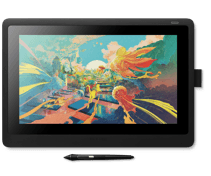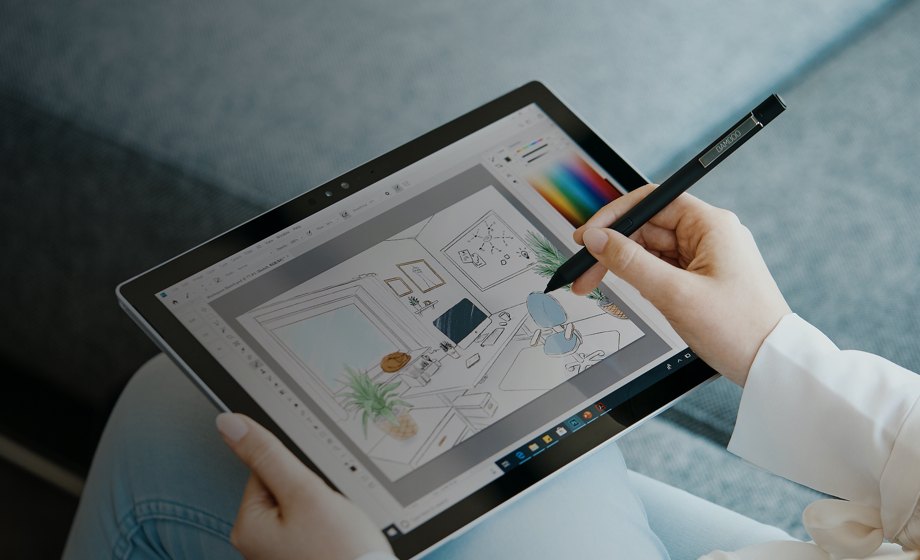Tavolette con penna
Puoi creare bozzetti, disegnare e modificare immagini con un pad reattivo e una penna precisa mentre vedi le tue creazioni prendere vita sullo schermo.


Che si tratti di creare un logo o di sviluppare tecniche di graphic design per realizzare icone, biglietti da visita o siti web di grande impatto visivo, questa guida ti fornisce consigli precisi su come diventare un designer migliore in qualunque ambito.

La creazione del proprio logo necessita di molte ricerche. Innanzi tutto, dai un'occhiata online a quelli che sono i loghi classici e alle caratteristiche che hanno in comune. In seguito, realizza una moodboard usando stampe di loghi che ti piacciono, per avere un riferimento visivo di quello che speri di ottenere. Prima di accendere il computer e aprire il tuo software di illustrazione, abbozza alcune idee con carta e penna, conservando anche gli scarabocchi più semplici: non puoi mai sapere se e come potrebbero tornarti utili. Se stai creando un logo per un brand, assicurati che rispetti la sua identità più ampia, dai font usati sui siti web al modo in cui si posiziona sul mercato.
Quando si tratta di disegnare concretamente il tuo logo, conviene mantenersi sul semplice. Ricorda che i loghi più famosi sono apparentemente semplici, per risultare più facili da ricordare. Per far sì che si distingua dagli altri, è utile imparare a creare font personalizzati e a usare colori che attirano l'attenzione. Se tutto questo ti sembra troppo impegnativo, puoi usare dei servizi online che ti permettono di creare un logo semplice per il tuo brand personale o per la tua start-up.

Per disegnare una carta intestata occorre adottare un approccio semplice. Trai ispirazione dall'identità del marchio, usando gli stessi temi e colori dei relativi siti web e biglietti da visita.
Per la carta intestata è importante usare software che supportino il disegno vettoriale. In questo modo potrai ridimensionare le immagini senza perdere qualità. Occorre usare anche le principali tecniche di graphic design relative alle gerarchie e agli allineamenti: decidi se la carta intestata deve mettere in risalto soprattutto il logo o il nome dell'azienda e disponili di conseguenza.
È essenziale ricordare che una lettera deve comunicare un messaggio specifico e che la carta intestata deve essere un elemento secondario, sebbene importante. Tenendo presente questo, cerca di non usare eccessivamente il colore e di evitare accozzaglie di elementi in cima alla pagina. Le informazioni di contatto possono sempre stare in basso sulla pagina, così da sfruttare al massimo tutto lo spazio di un foglio A4.

I biglietti da visita restano tuttora un accessorio indispensabile, anche nell'era digitale. Sebbene si possa essere tentati di rivolgersi a un servizio online per crearne uno, disegnare il proprio biglietto da visita può contribuire a rendere sé stessi e il proprio marchio più interessanti.
Ci sono alcune regole di base da tenere presenti. Assicurati che i testi non distino più di 5 mm dal bordo del biglietto. Stabilisci una dimensione minima per i caratteri in modo che siano ben leggibili e usa colori di base per mantenere semplice il tutto. Puoi iniziare disegnando una griglia, in modo da rispettare facilmente le gerarchie. Idealmente le dimensioni dovrebbero essere quelle di una carta di credito, così da entrare con facilità in un portafoglio.
Una volta creato il tuo biglietto, consultati con il servizio di stampa che vuoi usare per sapere se esistono delle tecniche speciali che potrebbero farlo risultare diverso dagli altri. Fustellature, laminature o bordi arrotondati sono tutti dettagli con cui differenziare i biglietti da visita rispetto alla massa.

Il web design è una carriera a sé stante. Questo non significa però che dovresti rinunciare a imparare le basi e che non dovresti provare a creare il tuo sito, che sia per un cliente o per il tuo brand.
Sebbene il web design sia in rapida evoluzione, ci sono alcune semplici regole da seguire. Prima di iniziare a creare il tuo sito web, assicurati di capire qual è l'obiettivo che si propone di raggiungere. Questo significa che dovrà avere una landing page semplice e chiara, così come delle call to action evidenti, che sono importanti soprattutto se sul sito viene venduto qualcosa. Conviene inoltre fare ricerche sulle attuali tendenze del web design, per capire se la moda del "brutalismo" e del minimalismo estetico ti possono essere d'ispirazione e decidere se vuoi che il tuo sito appaia simile agli altri o si distingua dalla massa.
Esiste una miriade di strumenti online che ti possono aiutare a creare il tuo sito: spesso contengono modelli già pronti per diversi tipi di siti. Sono estremamente utili e costituiscono la struttura di base di un buon sito web. Anche se usi questi potenti strumenti, è utile comprendere sia la teoria del colore che alcune basi del design come ad esempio il "formato F", secondo il quale le informazioni principali di un sito dovrebbero seguire la forma della lettera F, dal momento che questo è il modo con cui gli occhi degli utenti scansionano la pagina sullo schermo.
Le icone vengono create in serie, quindi devono stare bene insieme e appartenere a un gruppo. A tal fine è importante iniziare da forme semplici: disegna un'icona usando cerchi, triangoli o quadrati, prima di passare alle rifiniture.
Inizia ogni disegno con una griglia preimpostata e un bordo preciso, in modo che tutte le icone abbiano un aspetto uniforme sin dall'inizio. In seguito, dai vita ai tuoi bozzetti su carta usando dei software di design. È fondamentale usare coerenza. Questo significa che aggiungere a ogni icona un piccolo dettaglio, come un angolo ritagliato o una curva, fa sì che appaiano tutte correlate. È bene evitare di tracciare le curve manualmente e affidarsi piuttosto a un software per disegnarle, per assicurarsi che siano ogni volta perfette.
Poiché le icone tendono a essere piccole, e lo sono ancora di più sugli schermi degli smartphone, è essenziale mantenere allineati i pixel. Gli angoli di un'icona che non sono stati allineati correttamente possono apparire storti e malfatti.
Come per tutti i buoni design, la semplicità è essenziale, a maggior ragione per le icone. Le decorazioni eccessive sono difficili da distinguere e fanno apparire le icone troppo elaborate.

L'identità visiva dovrebbe riguardare l'intero brand, a partire dal suo sito web fino ai biglietti da visita, i loghi, gli schemi di colori e i font. Prima di dedicarsi alla progettazione di tutti questi elementi, è importante condurre ricerche sulle persone che interagiscono con il marchio e capire esattamente quali sono gli obiettivi dello stesso. Le risposte a queste domande costituiranno una buona base per la creazione di un'identità visiva. Ti diranno se l'aspetto dovrà essere serio o giocoso, moderno o tradizionale.
È essenziale che l'identità visiva sia coerente. Questo significa usare gli stessi colori per tutti gli elementi e capire che colori diversi possono evocare emozioni diverse. Se un marchio realizza app per il miglioramento della salute mentale, un tranquillo blu calmante sarà meglio di uno sgargiante rosso. I font devono essere gli stessi ovunque e non ne vanno usati più di due. Devono essere uno complementare all'altro e usati in modo coerente per le call to action di uno stesso sito web, per la carta intestata e i biglietti da visita.
Assicurati che tutte le immagini usate online o nei materiali promozionali rappresentino la missione del marchio e le persone che lo usano. Un'identità visiva ben precisa può essere facilmente compromessa da immagini che non sono in linea con il marchio nel suo complesso.
Qualsiasi cosa tu stia progettando, con Wacom Cintiq ne hai il pieno controllo. I colori vivi, la nitidezza HD e il design ergonomico si uniscono alla penna Wacom Pro Pen 2 altamente reattiva per offrire un’esperienza naturale e fare evolvere le tue idee di design a un livello superiore. I risultati parleranno da sé.
Prodotti consigliati

Wacom Cintiq 16
Disegna, progetta e crea direttamente su uno schermo ad alta risoluzione con una penna precisa.

Puoi creare bozzetti, disegnare e modificare immagini con un pad reattivo e una penna precisa mentre vedi le tue creazioni prendere vita sullo schermo.

Disegna, progetta e crea con una penna precisa direttamente su uno schermo ad alta risoluzione.

Crea di tutto e ovunque con una maggiore potenza di elaborazione, una penna precisa e uno splendido display.

Scrivi con la penna sulla carta e converti in digitale i tuoi appunti manuali.

Scrivi e metti nero su bianco le tue idee sul tuo dispositivo mobile con una penna digitale Wacom.
L’idea di Wacom è quella di avvicinare persone e tecnologia attraverso tecnologie naturali. È questo che l'ha resa leader al mondo nella produzione di tavolette con penna e display interattivi, penne digitali e soluzioni per il salvataggio e l'elaborazione di firme digitali. La tecnologia all’avanguardia dei dispositivi Wacom è stata utilizzata per creare alcune delle più emozionanti opere d’arte digitali, film, effetti speciali, moda e design del mondo. La sua tecnologia ad altissimi livelli consente sia ad aziende che a privati di esprimere la propria personalità. Fondata nel 1983, Wacom è un’azienda internazionale con sede in Giappone (Tokyo Stock Exchange: 6727) e uffici in tutto il mondo a supporto del marketing e della distribuzione in oltre 150 paesi.